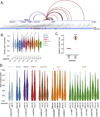Noncoding somatic and inherited single-nucleotide variants converge to promote ESR1 expression in breast cancer
- PMID: 27571262
- PMCID: PMC5042848
- DOI: 10.1038/ng.3650
Noncoding somatic and inherited single-nucleotide variants converge to promote ESR1 expression in breast cancer
Abstract
Sustained expression of the estrogen receptor-α (ESR1) drives two-thirds of breast cancer and defines the ESR1-positive subtype. ESR1 engages enhancers upon estrogen stimulation to establish an oncogenic expression program. Somatic copy number alterations involving the ESR1 gene occur in approximately 1% of ESR1-positive breast cancers, suggesting that other mechanisms underlie the persistent expression of ESR1. We report significant enrichment of somatic mutations within the set of regulatory elements (SRE) regulating ESR1 in 7% of ESR1-positive breast cancers. These mutations regulate ESR1 expression by modulating transcription factor binding to the DNA. The SRE includes a recurrently mutated enhancer whose activity is also affected by rs9383590, a functional inherited single-nucleotide variant (SNV) that accounts for several breast cancer risk-associated loci. Our work highlights the importance of considering the combinatorial activity of regulatory elements as a single unit to delineate the impact of noncoding genetic alterations on single genes in cancer.
Figures




References
-
- Green KA, Carroll JS. Oestrogen-receptor-mediated transcription and the influence of co-factors and chromatin state. Nat Rev Cancer. 2007;7:713–722. - PubMed
-
- Vincent-Salomon A, Raynal V, Lucchesi C, Gruel N, Delattre O. ESR1 gene amplification in breast cancer: a common phenomenon? Nat Genet. 2008;40:809. author reply 810-2. - PubMed
-
- Horlings HM, et al. ESR1 gene amplification in breast cancer: a common phenomenon? Nat Genet. 2008;40:807–808. author reply 810-2. - PubMed
-
- Reis-Filho JS, et al. ESR1 gene amplification in breast cancer: a common phenomenon? Nat Genet. 2008;40:809–810. author reply 810-2. - PubMed
MeSH terms
Substances
Grants and funding
LinkOut - more resources
Full Text Sources
Other Literature Sources
Medical
Molecular Biology Databases
Research Materials
Miscellaneous

